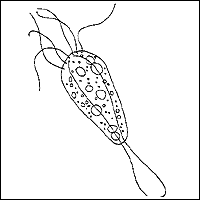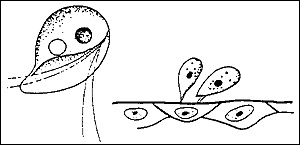

 |
||||||||||||
 |
||||||||||||
| Introduction to Freshwater Fish Parasites | ||||||
| Page 6 of 14 | Pages: 1 . 2 . 3 . 4 . 5 . 6 . 7 . 8 . 9 . 10 . 11 . 12 . 13 . 14 | |||||
Flagellates Flagellated protozoans are small parasites that can infect fish externally and internally. They are characterized by one or more flagella that cause the parasite to move in a whip-like or jerky motion. Because of their small size, their movement, observed at 200 or 400x magnification under the microscope, usually identifies flagellates. Common flagellates that infest fish are given below. Hexamita / Spironucleus Hexamita is a small (3 -- 18 m) intestinal parasite commonly found in the intestinal tract of freshwater fish ( Figure 10 ). Sick fish are extremely thin and the abdomen may be distended. The intestines may contain a yellow mucoid (mucus-like) material. Recent taxonomic studies have labeled the intestinal flagellate of freshwater angelfish as Spironucleus. Hexamita or Sprironucleus can be diagnosed by making a squash preparation of the intestine and examining it at 200 or 400x magnification. The flagellates can be seen where the mucosa (intestinal lining) is broken. They move by spiraling and in heavy infestations, they will be too numerous to be overlooked.  Figure 10: An illustration of a Hexamita parasite.
Figure 10: An illustration of a Hexamita parasite.
The recommended treatment for Hexamita / Spironucleus is metronidazole (Flagyl). Metronidazole can be administered in a bath at a concentration of 5 mg/L (18.9 mg/gallon) every other day for three treatments. Medicated feed is even more effective at a dosage of 50 mg/kg body weight (or 10 mg/gm food) for five consecutive days. See also IFAS Fact Sheet VM-67 , Management of Hexamita in Ornamental Cichlids . Ichthyobodo Ichthyobodo, formerly known as Costia, is a commonly encountered external flagellate ( Figure 11 ). Ichthyobodo- infected fish secrete copious amounts of mucus. Mucus secretion is so heavy that catfish farmers popularly refer to the disease as "blue slime disease". Infected angelfish also produce excessive mucus that can give dark colored fish a gray or blue coloration along the dorsal body wall. Infected fish flash and lose condition, often characterized by a thin, unthrifty appearance.  Figure 11: An illustration of a Ichthyobodo flagellate.
Figure 11: An illustration of a Ichthyobodo flagellate.
Ichthyobodo can be located on the gills, skin, and fins, however, it is difficult to identify because of its small size. The easiest way to identify Ichthyobodo is by its corkscrew swimming pattern. With a good microscope, the attached organism can be seen at 400x magnification. The organism is easily controlled using one application of one of the treatments listed in Table 1. more ... |
 |
|||||
| About Us :: Message Board :: Chat | |||||
| Library :: Photo Gallery :: Links & Resources :: Breeders & Sponsors :: Merchandise | |||||
| Website designed by: EthanCote.com | © 2001-2004, SimplyDiscus.com. All Rights Reserved. | ||||